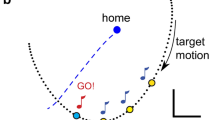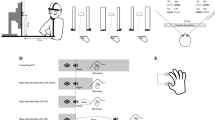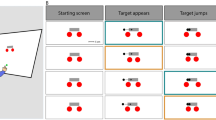Abstract
Moving around obstacles requires balancing the need to avoid collisions with the need to minimize biomechanical costs. We investigated this tradeoff by studying the effects of visual uncertainty, motor noise, and practice on clearance over obstacles in a manual positioning task. Participants moved a manipulandum back and forth over a stationary obstacle. We varied visual uncertainty by placing the obstacle at different heights relative to participants’ eyes, and we varied motor noise by having participants hold the object to be moved at different positions relative to the range of motion of the arm joints. Clearance was larger in conditions of higher visual uncertainty than in conditions of lower visual uncertainty, larger in the higher motor noise conditions than in the lower motor noise conditions, and larger early in practice than late in practice. The results indicate that spatial accuracy and biomechanical costs are both taken into account during reaching over obstacles, but to differing degrees across practice.


Similar content being viewed by others
References
Bertamini M, Yang TL, Proffitt DR (1998) Relative size perception at a distance is best at eye level. Percept Psychophys 60:673–682
Buchanan JJ, Park JH, Shea CH (2004) Systematic scaling of target width: dynamics, planning, and feedback. Neurosci Lett 367:317–322
Bullock D, Bongers RM, Lankhorst M, Beek PJ (1999) A vector-integration-to-endpoint model for performance of viapoint movements. Neural Netw 12:1–29
Clarkson H (1999) Musculoskeletal assessment: joint range of movement and manual muscle strength, 2nd edn. Lippincott Williams & Wilkins, Philadelphia, p 18
Elliott D, Chua R, Pollock BJ, Lyons J (1995) Optimizing the use of vision in manual aiming: the role of practice. Q J Exp Psychol A 48:72–83
Elliott D, Hansen S, Mendoza J, Tremblay L (2004) Learning to optimize speed, accuracy, and energy expenditure: a framework for understanding speed-accuracy relations in goal-directed aiming. J Motor Behav 36:339–351
Fitts PM (1954) The information capacity of the human motor system in controlling the amplitude of movement. J Exp Psychol 47:381–391
Flash T, Hogan N (1985) The coordination of arm movements: an experimentally confirmed mathematical model. J Neurosci 5:1688–1703
Gepshtein S, Seydell A, Trommershäuser J (2007) Optimality of human movement under natural variations of visual-motor uncertainty. J Vis 7:1–18
Harris CM, Wolpert DM (1998) Signal-dependent noise determines motor planning. Nature 394:780–784
Jax SA, Rosenbaum DA, Vaughan J (2007) Extending Fitts’ Law to manual obstacle avoidance. Exp Brain Res 180:775–779
Körding KP, Wolpert DM (2004) Bayesian integration in sensorimotor learning. Nature 427:244–247
Lyons J, Hansen S, Hurding S, Elliott D (2006) Optimizing rapid aiming behaviour: movement kinematics depend on the cost of corrective modifications. Exp Brain Res 174:95–100
Meyer DE, Kornblum S, Abrams RA, Wright CE, Smith JEK (1988) Optimality in human motor performance: ideal control of rapid aimed movements. Psychol Rev 95:340–370
Oliviera FT, Elliott D, Goodman D (2005) Energy-minimization bias: compensating for intrinsic influence of energy-minimization mechanisms. Motor Control 9:101–114
Putz-Anderson V, Galinsky TL (1993) Psychophysically determined work durations for limiting shoulder girdle fatigue from elevated manual work. Int J Ind Ergon 11:19–28
Rosenbaum DA, van Heugten C, Caldwell GC (1996) From cognition to biomechanics and back: the end-state comfort effect and the middle-is-faster effect. Acta Psychologica 94:59–85
Rosenbaum DA, Meulenbroek RG, Vaughan J, Jansen C (2001) Posture-based motion planning: applications to grasping. Psychol Rev 108:709–734
Rossetti Y, Meckler C, Prablanc C (1994) Is there an optimal arm posture? Deterioration of finger localization precision and comfort sensation in extreme arm-joint postures. Exp Brain Res 99:131–136
Sabes PN, Jordan MI (1997) Obstacle avoidance and a perturbation sensitivity model for motor planning. J Neurosci 15:7119–7128
Sabes PN, Jordan MI, Wolpert DM (1998) The role of inertial sensitivity in motor planning. J Neurosci 18:5948–5957
Shannon CE (1949) Communication in the presence of noise. Proc IRE 37:10–21
Soechting JF, Buneo CA, Herrmann U, Flanders M (1995) Moving effortlessly in three dimensions: does Donders’ Law apply to arm movement? J Neurosci 15:6271–6280
Sood D, Nussbaum MA, Hager K (2007) Fatigue during prolonged intermittent overhead work: reliability of measures and effects of working height. Ergonomics 50:497–513
Starkes J, Helsen W, Elliott D (2002) A ménage à trois: the eye, the hand and on-line processing. J Sports Sci 20:217–224
Trommershäuser J, Maloney LT, Landy MS (2003) Statistical decision theory and trade-offs in the control of motor response. Spat Vis 16:255–275
Uno Y, Kawato M, Suzuki R (1989) Formation and control of optimal trajectory in human multijoint arm movement: minimum torque-change model. Biol Cybern 61:89–101
Vaughan J, Rosenbaum DA, Meulenbroek RGJ (2001) Planning reaching and grasping movements: the problem of obstacle avoidance. Motor Control 5:116–135
Woodworth RS (1899) The accuracy of voluntary movement. Psychol Rev. Monograph Supplement 13, July
Worringham CJ (1991) Variability effects on the internal structure of rapid aiming movements. J Motor Behav 23:75–85
Worringham CJ (1993) Predicting motor performance from variability measures. In: Newell KM, Corcos DM (eds) Variability and motor control. Human Kinetics, Champaign, IL, pp 53–63
Acknowledgments
This work was supported in part by a Graduate Fellowship from Penn State University and by an NIH training grant to OHSU. We thank Lindsay Hopkins, Meredith Miller, Meghann Ramsey, Christine Schiller, Layne Vashro, and Matthew Walsh for help in the lab. We also thank Digby Elliott, Mel Goodale, and an anonymous reviewer for helpful comments on an earlier write-up of this work.
Author information
Authors and Affiliations
Corresponding author
Rights and permissions
About this article
Cite this article
Cohen, R.G., Biddle, J.C. & Rosenbaum, D.A. Manual obstacle avoidance takes into account visual uncertainty, motor noise, and biomechanical costs. Exp Brain Res 201, 587–592 (2010). https://doi.org/10.1007/s00221-009-2042-8
Received:
Accepted:
Published:
Issue Date:
DOI: https://doi.org/10.1007/s00221-009-2042-8




